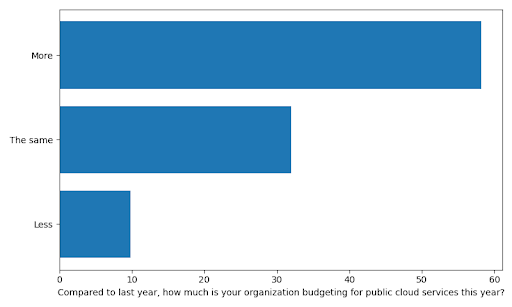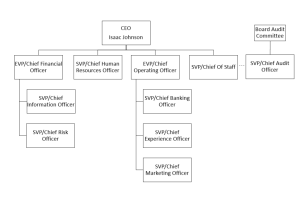
Recently, there’s been a lot of talk about “cloud repatriation.” The idea isn’t new; Dropbox abandoned AWS in 2015, 37Signals announced they were backing out last October, and there has been a flurry of articles about repatriation in the trade press.
But are companies actually moving out of the cloud? To find out, O’Reilly Media surveyed its users, receiving 713 responses. Were their companies investing more? Were they pulling back and canceling projects? The latter seemed especially likely, particularly given all the media-driven talk of a recession.
The answer is “No.” The idea that a significant number of companies are backing away from the cloud is a myth. 58% of the respondents said that their company would be spending more on the cloud this year than last; 32% were spending roughly the same amount; only 10% were spending less. With 90% of the respondents reporting that their cloud expense is the same or increasing year over year, it’s difficult to conclude that repatriation is a significant phenomenon.

When asked what percentage of their services had moved to the cloud, only 6% of the respondents said “none.” That’s a very small percentage of non-starters, and in line with our 2021 Cloud Adoption survey, where roughly 90% of the respondents said that their organizations were using the cloud. It’s more interesting that over half of the respondents are closer to the start of their cloud journey than to the end: 53% reported that less than half of their services had moved to the cloud. Only 11% reported that their company was scaling back their plans to move services to the cloud; as you’d expect, that number is comparable to the number who reported spending less on cloud services. Only 15% reported that they had already moved all of their services to the cloud, while 43% said that the transition to the cloud was ongoing. I have long felt that most surveys have overstated enterprise investment in the cloud, but these results provide some more detail. Enterprises are no longer experimenting and kicking the tires; almost every company has moved some services to the cloud. We’re clearly only in the middle stages of the cloud transition–but most companies have a ways to go before they’re finished. The cloud is still a “growth industry,” and will remain one for the foreseeable future.
This finding leads us to another question: why are companies sticking with the cloud, especially in a year where there’s a lot of economic pressure to cut costs? There are three classic use cases: startups that can’t afford the expense of a data center, simple applications that can rely entirely on managed services, and applications that have huge swings in usage (for example, retail on Black Friday). But there are many other reasons to move to the cloud, and all of them hit a business’s bottom line in ways that aren’t immediately obvious.
Here are a few:
- Business continuity: O’Reilly has had to scramble to stay online several times in the past few decades; both flooding and the California wildfires have been issues. Moving to the cloud has reduced that risk. It’s easy to point to AWS’s occasional outages, but with good engineering it’s possible to design systems that can shift loads to other zones. Netflix has been able to weather Amazon outages without going down. And it’s no surprise that cloud vendors offer business continuity as a service.
- Scalability: It’s easy to dismiss companies that experience huge load swings as a special case. But occasionally new products and services are more popular than anticipated–and that’s a good thing. However, when a product exceeds expectations, it’s too late to order servers, wait for delivery, and rack them in a server room or colocation facility. You want to click a few buttons on a management console, and have more servers online instantly.
- Security: Yes, everyone talks about “cloud security” as a problem. However, there’s little businesses need to do for cloud security that they shouldn’t do on-premises: zero-trust, multi-factor authentication, least privilege, etc. Cloud providers have the staff and the tools to monitor security 24/7, a luxury and skillset that smaller companies can’t afford.
- Performance: At one of O’Reilly’s earliest Velocity conferences, a presentation by Microsoft and Google showed that even small increases in response time hurt every user engagement metric. Those metrics got worse as the latency grew. A cloud provider provides points of presence close to just about every major city, something that would be expensive for a business to build and difficult to manage on its own.
There are many other reasons to move to the cloud. Limiting the cloud to a few use cases, or thinking simplistically about expense, isn’t reasonable. An analysis of whether the cloud makes sense for your company needs to take into account everything the cloud provides, ranging from improved performance to knowing that you won’t go offline if a wildfire threatens your office. Of course, it’s important to keep the downsides in mind. Moving to the cloud can be a heavy lift for an IT department that’s understaffed and under skilled. Expenses can grow significantly if cloud usage isn’t managed appropriately.
The number of respondents (20%) who said they weren’t doing anything to manage cloud costs was surprising. 20% isn’t a large number, but it’s certainly significant. This shouldn’t be interpreted as a sign that cost isn’t an issue; it’s a sign that poor cost management is more widespread than we would have guessed. It is easy to use the cloud inefficiently, and easy to ignore this drain on a company’s bottom line. Cloud expenses can grow unnoticed, like the legendary boiling frog. It’s easy to add a server instance here or a managed service there, each time adding a bit to the monthly bill. It’s easy to spin up a lot of instances, and “forget” to shut them down when they’re no longer needed.
So what strategies do our respondents use to control cloud expense? 28% of the respondents said that they manage the number of instances in use dynamically, adding and terminating them as needed. Workloads that don’t vary day to day and hour to hour are the exception, not the rule, and we suspect that many companies do a poor job of managing their fleet of instances–and the ability to size infrastructure dynamically has always been a key selling point for the cloud. An expanding tools ecosystem, including container orchestration tools like Kubernetes, can do a lot to keep an “instance farm” under control. A third (34%) of the respondents are using cost optimization tools; all of the major cloud providers provide these tools, in addition to third-party vendors.
Are organizations moving away from the cloud? No. There isn’t any substantial evidence of repatriation. Though some respondents report that they’re reducing cloud expense, or migrating back to on-premises, their numbers are small. Cloud expenses don’t seem to be a big issue, even though we get the uneasy feeling that many companies are doing a poor job of managing cloud costs. Still, no one is rushing to the exits–and we don’t expect them to start.
By Mike Loukides

